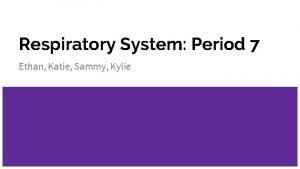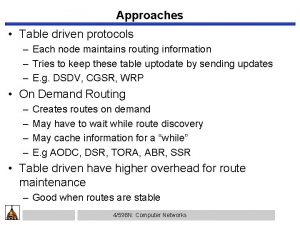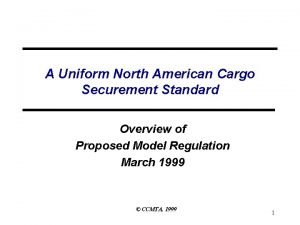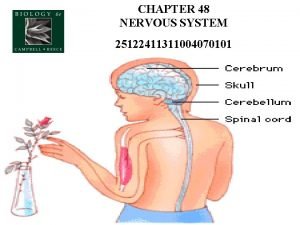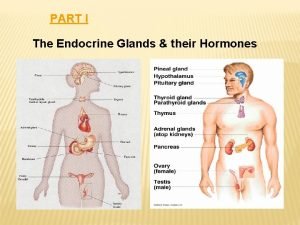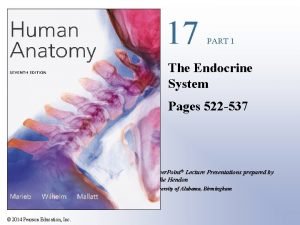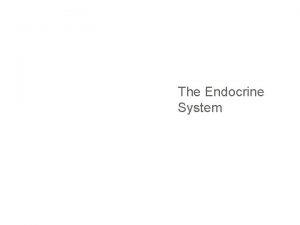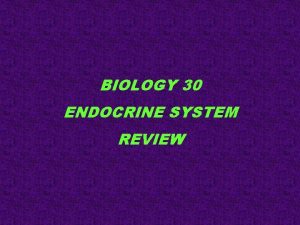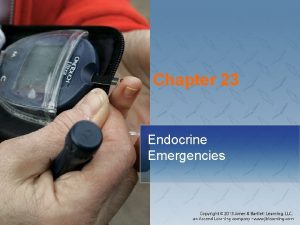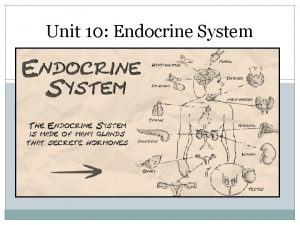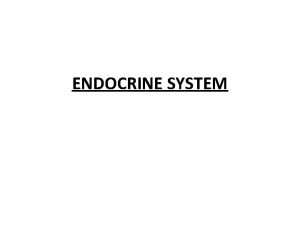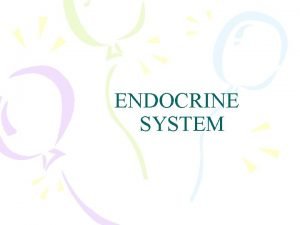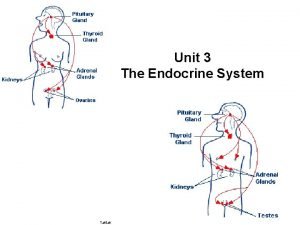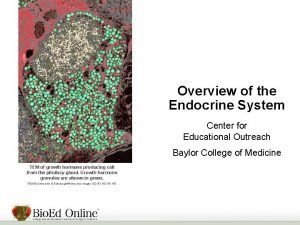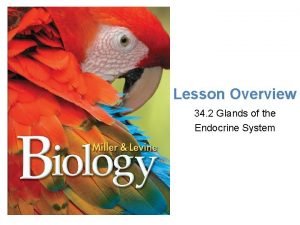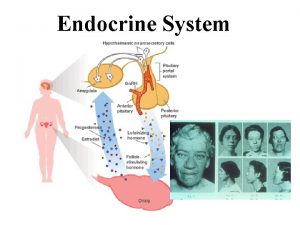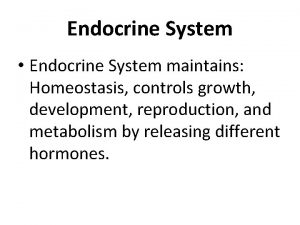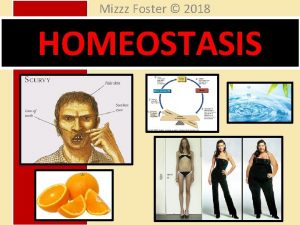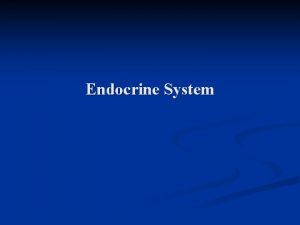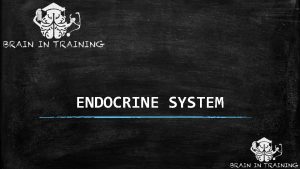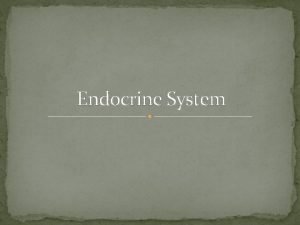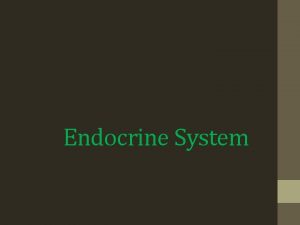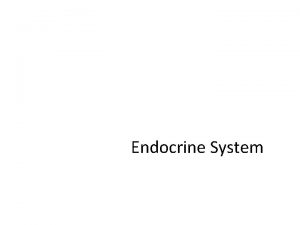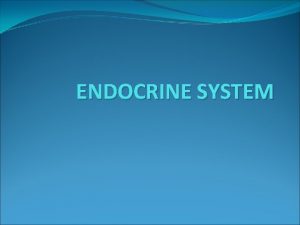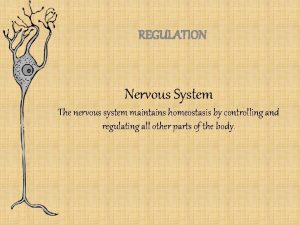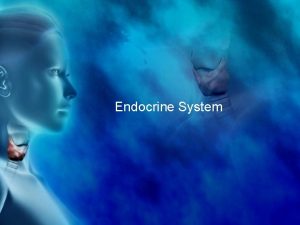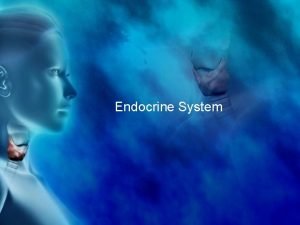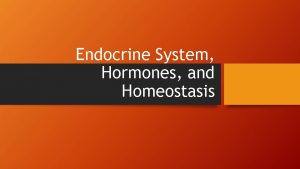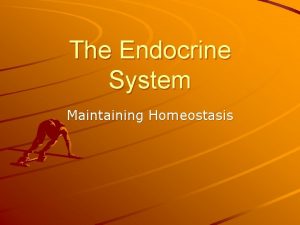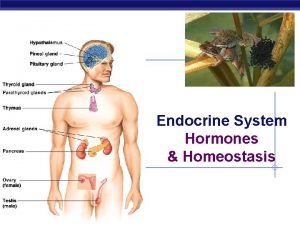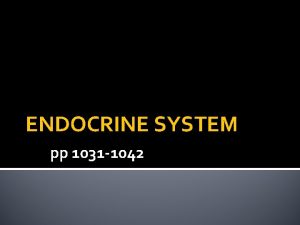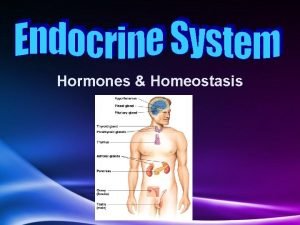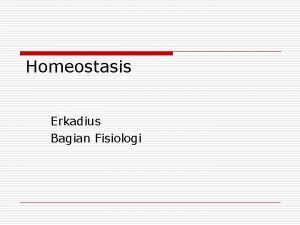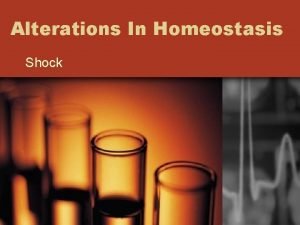Endocrine Physiology Endocrine system maintains homeostasis The concept










































- Slides: 42

Endocrine Physiology

Endocrine system maintains homeostasis ▪ The concept that hormones acting on distant target cells to maintain the stability of the internal milieu (Environment) was a major advance in physiological understanding. ▪ The secretion of the hormone was evoked (Recalled) by a change in the environment and the resulting action on the target cell restored the milieu to normal. ▪ The desired return to the normal status results in the maintenance of homeostasis.

Sensing and signaling • Endocrine “glands” synthesize and store hormones. • These glands have a sensing and signaling system which regulate the duration and magnitude of hormone release via feedback from the target cell.

Endocrine vs. Nervous System ▪ Both of them are the major communication systems in the body. ▪ They integrate stimuli and responses to changes in external and internal environment. ▪ Both are crucial to coordinated functions of highly differentiated cells, tissues and organs. ▪ Unlike the nervous system, the endocrine system is anatomically discontinuous.

Nervous system • The nervous system exerts point-to-point control through nerves, similar to sending messages by conventional telephone. • Nervous control is electrical in nature and fast.

Hormones travel via the bloodstream to target cells • The endocrine system broadcasts its hormonal messages to essentially all cells by secretion into blood and extracellular fluid. • Like a radio broadcast, it requires a receiver to get the message, in the case of endocrine messages, cells must bear a receptor for the hormone being broadcast in order to respond.

A cell is a target because it has a specific receptor for the hormone v Most hormones circulate in blood, coming into contact with essentially all cells. v However, a given hormone usually affects only a limited number of cells, which are called target cells. A target cell responds to a hormone because it bears receptors for the hormone.

Principal functions of the endocrine system ▪ Maintenance of the internal environment in the body (maintaining the optimum biochemical environment). ▪ Integration and regulation of growth and development. ▪ Control, maintenance and instigation of sexual reproduction, including gametogenesis, coitus, fertilization, fetal growth and development and nourishment of the newborn.

Types of cell-to-cell signaling v Classic endocrine hormones travel via bloodstream to target cells. v Neurohormones are released via synapses and travel via the bloostream. v Paracrine hormones act on adjacent cells. v Autocrine hormones are released and act on the cell that secreted them. v Also, intracrine hormones act within the cell that produces them.

Response vs. distance traveled v Endocrine action: the hormone is distributed in blood and binds to distant target cells. v Paracrine action: the hormone acts locally by diffusing from its source to target cells in the neighborhood. v Autocrine action: the hormone acts on the same cell that produced it.

Endocrine System ▪ Control pathways: may be through: ▪ Negative feedback loops ▸ Stabilizing a function and maintain it within a normal range ▸ Response is in opposition to stimuli ▸ Homeostatic control

▪ Positive feedback loops ▸ Response reinforces the stimulus ▸ Response destabilizes the variable ▸ Requires an event outside the loop to stop them ▪ Feed-forward control ▸ Anticipates change (act as a forerunner or Expecting) ▸ Starts the response loop before the change has occurred

▪ Control systems vary in their speed & specificity ▸ Specificity – Nervous control very specific – Hormonal control more general ▸ Nature of signal – Nervous system uses both electrical and chemical – Endocrine system uses only chemicals ▸ Speed – Nervous system much faster, up to 120 m/sec – Endocrine system much slower ▸ Duration of action – Nervous system shorter, very brief – Endocrine system lasts longer

Endocrine System ▸ It brings about changes via chemical messengers, hormones, released into the blood stream and carried to target organs. ▸ Endocrinology - the study of hormones and the endocrine organs. ▸ Endocrine system - all of the glands that secrete hormones

Endocrine and exocrine glands ▸ Exocrine glands - have ducts through which their nonhormonal products travel to the membrane surface and to the exterior (epithelial surface) ▸ Endocrine glands - release their substances into the surrounding fluid (ductless glands). They include the pituitary, thyroid, parathyroid, adrenal, pineal, and the thymus glands. Also included are the pancreas and gonads. The hypothalamus is called a neuroendocrine organ.


Endocrine System, Hormones ▪ Hormones - chemical messengers carried by the blood from endocrine glands to the cell upon which they act. ▸ Are chemical messengers ▸ Secreted into the blood by endocrine cells or neurons ▸ Affect distal targets ▪ Affect target cells by controlling: ▸ ▸ Rate of enzymatic reactions Transport of molecules across cell membrane Gene expression and protein synthesis Stimulation of mitosis

Endocrine System, Hormones ▪ Classification ▸ Peptide hormones - 3 or more amino acids ▸ Steroid hormones - derived from cholesterol ▸ Amine hormones - single amino acids

Endocrine System, Hormones ▪ Classification, Peptide hormone - eg: Insulin ▸ Synthesis - RER, preprohormone. ▸ Packaged in vescicles. ▸ In Golgi apparatus, pre to pro hormone then to hormone and fragments. ▸ Released into ECF when cell is signaled to do so. ▸ Transported in blood, half-life – minutes. ▸ Mechanism of action - bind to cell surface receptors. Many use c. AMP and some use tyrosine kinase. ▸ Action - open or close membrane channels or modulate metabolic enzymatic activity or transport proteins.

▪Peptide hormone synthesis, packaging, ▪and release

Endocrine System, Hormones ▪ Classification, Steroid hormones, e. g: estradiol ▸ Synthesis - SER, lipophilic, sythesized as needed ▸ Found bound (inactive) to protein carriers in blood ▸ Half-life - hours ▸ Mechanism - diffuses across cell membrane to cytoplasmic and nuclear receptors. Interact with DNA ▸ Slow response by cells - hours

Endocrine System, Hormones ▪ Action of Steroid Hormones

Endocrine System, Hormones ▪ Classification, Amine hormones: ▸ Nitrogen-containing. ▸ Most derived from tryptophan or tyrosine. ▸ They behave like peptide hormones (catecholamines) or like steroid hormones (thyroid hormones). ▸ Thyroid hormones: produced by thyroid gland found in the lower part of the neck. It secretes 3 hormones: – Thyroxine - T 4 – Triiodothyromine - T 3 – Calcitonin ▸ The first two are collectively known as thyroid hormones (TH) and contain iodine. ▸ Virtually every tissue in the body is affected by TH.

Endocrine System, Hormones ▪ Amine hormone, Adrenal medullary hormones: ▸ The adrenal gland consists of a medullary and cortical section. The cortex secretes steroid hormones. ▸ The adrenal medulla secretes two hormones: – Epinephrine (E) and – Norepinephrine (NE) ▸ These are also called catecholamines.

Endocrine System, Hormones ▪ Second messenger mechanisms of amino ▪ acid-based hormones

Quiz ▪ It takes much longer for sex hormones and other steriods to produce their effects than it takes nonsteroid hormones. Why? ▸ A. Steroids are bigger, slower molecules ▸ B. Steroids usually must be carried longer distances in the blood ▸ C. Steroids cause target cells to make new proteins, which takes time ▸ D. Steroids must relay their message via a second messenger ▸ E. It takes longer for endocrine cells to make and secrete steroids

Endocrine System, Hormones ▪ Steroid hormones ▸ Produced by the adrenal cortex, the gonads, and the placenta. ▸ All steroid hormones are derived from cholesterol and differ only in the ring structure and side chains attached to it. ▸ All steroid hormones are lipid soluble

Steroid hormones ▸ When the structure is modified, a series of suffixes is used to indicate the change. ▸ If the name of the compound ends in. –ane, then the molecule has single bonds between the carbon atoms in the rings. ▸ If there are double bonds between the carbon atoms, the suffix -ene is used.

Steroid hormones ▸ If a hydrogen atom is replaced by an -OH group, the suffix -ol is used as in cholesterol; cortisol and oestradiol.

Steroid hormones ▸ If two hydrogen atoms are replaced by an oxygen atom, the suffix -one is employed, as in aldosterone and progesterone.

Types of steroid hormones ▪ Glucocorticoids; cortisol is the major representative in most mammals. ▪ Mineralocorticoids; aldosterone being most prominent. ▪ Androgens such as testosterone. ▪ Estrogens, including estradiol and estrone. ▪ Progestogens (also known a progestins) such as progesterone.

Steroid hormones ▪ Are not packaged, but synthesized and immediately released. ▪ Are all derived from the same parent compound: Cholesterol. ▪ Enzymes which produce steroid hormones from cholesterol are located in mitochondria and smooth ER. ▪ Steroids are lipid soluble and thus are freely permeable to membranes so are not stored in cells.

Steroid hormones ▪ Steroid hormones are not water soluble so have to be carried in the blood complexed to specific binding globulins. ▪ Corticosteroid binding globulin carries cortisol. ▪ Sex steroid binding globulin carries testosterone and estradiol. ▪ In some cases a steroid is secreted by one cell and is converted to the active steroid by the target cell: an example is androgen which secreted by the gonad and converted into estrogen in the brain.

Endocrine System, Hormones ▪ Direct gene activation mechanism of ▪ steroid hormones

Endocrine System, Control of Hormone Release ▪ Endocrine glands are stimulated by humoral, neural and hormonal means. ▸ Humoral stimuli - changing levels of blood ions and nutrients. Example: ↓calcium →↑parathyroid hormone. ▸ Neural stimuli - nerve fiber stimulates hormonal release. Example: ↑nervous input to adrenal medulla → release of catecholamines ▸ Hormonal stimuli (tropic hormones) - endocrine glands release their hormones in response to hormones produced by other endocrine organs. Example: hypothalamic hormones → anterior pituitary to release hormones → other endocrine glands to produce even more hormones.

Endocrine System, Neurohormones ▪ Hypothalamic-pituitary system ▸ Pituitary gland - lies just below hypothalamus, in pocket of bone at base of brain. Consists of two adjacent lobes - the anterior pituitary and the posterior piruitary ▸ Posterior pituitary hormones – Oxytocin and vasopressin are released – Made in hypothalamus, move down the neural axons and accumulate in the axon terminals in the posterior pituitary – Vasopressin - blood pressure and kidney function – Oxytocin - breasts and uterine contractions

Endocrine System, Neurohormones ▪ Hypothalamus and Anterior Pituitary: ▸ The hypothalamus also secretes hormones that control the secretion of ALL the anterior pituitary hormones. The basic pattern is as follows: – Secretion of a hypothalamic hormone, which controls secretion of – An anterior pituitary hormone, which controls the secretion of – A hormone from some other endocrine organ/gland ▸ Anterior Pituitary Hormones – At least eight secreted, six with well-established functions

Endocrine System, Neurohormones

Endocrine System, Neurohormones Stimulus Hypothalamus ↑Hormone 1 Secretion ↑Plasma Hormone 1 Anterior Pituitary ↑Hormone 2 Secretion ↑Plasma Hormone 2 Third Endocrine Gland ↑Hormone 3 Secretion ↑Plasma Hormone 3 Target Cells Respond to Hormone 3

Endocrine System ▪ Hypothalamic Releasing Hormones: ▸ Corticotropin Releasing Hormone (CRH) ▸ Thyrotropin Releasing Hormone (TRH) ▸ Growth Hormone Releasing Hormone (GHRH) ▸ Somatostatin (SS) also called Growth hormone releasing Inhibitin Hormone (GIH) ▸ Gonadotropin Releasing Hormone (Gn. RH) ▸ Prolactin Releasing Hormone (PRH) ▸ Prolactin releasing Inhibiting Hormone (PIH)

Endocrine System ▪ Anterior Pituitary Hormones: ▸ Gonadotropic Hormones – Follicle-Stimulating Hormone (FSH) – Luteinizing Hormone (LH) ▸ Growth Hormone (GH) ▸ Thyroid-stimulating Hormone (TSH) ▸ Prolactin ▸ Adreno Cortico Tropic Hormone (ACTH) ▸ β-Lipotropic Hormone ▸ β-Endorphin

Hypothalamus Gn. RH GHRH SS TRH PIH PRH CRH Anterior Pituitary FSH and LH Gonads Germ cell development Hormones-estrogen, progesterone and testosterone GROWTH HORMONE Liver Other organs IGF-1 Growth Metabolism TSH PROLACTIN Thyroid Breasts Thyroxine T 3 Development Milk ACTH Adrenal cortex Cortisol Summary of Hypothalamic-anterior-pituitary system
 Respiratory system maintain homeostasis
Respiratory system maintain homeostasis Bioflix activity homeostasis hormones and homeostasis
Bioflix activity homeostasis hormones and homeostasis Bioflix activity homeostasis hormones and homeostasis
Bioflix activity homeostasis hormones and homeostasis Endocrine system and reproductive system
Endocrine system and reproductive system Endocrine system and nervous system
Endocrine system and nervous system Lympathic
Lympathic Mechanism of action of hormones
Mechanism of action of hormones Endocrine system and nervous system
Endocrine system and nervous system Maslow's theory maintains that________.
Maslow's theory maintains that________. Integrative social contracts theory maintains that
Integrative social contracts theory maintains that In each node maintains a vector (table)
In each node maintains a vector (table) Indirect tie down
Indirect tie down Maslow's theory maintains that
Maslow's theory maintains that Integrated social contracts theory maintains that
Integrated social contracts theory maintains that Social needs
Social needs In scrum, the ____ maintains the product backlog list.
In scrum, the ____ maintains the product backlog list. Nervous system homeostasis
Nervous system homeostasis Chapter 16 matching questions 6-10
Chapter 16 matching questions 6-10 Parts of the endocrine system
Parts of the endocrine system Sympathetic nervous system
Sympathetic nervous system Comparison of endocrine and nervous system
Comparison of endocrine and nervous system Steroids endocrine system
Steroids endocrine system Facts about the endocrine system
Facts about the endocrine system Rat external anatomy
Rat external anatomy Chapter 45 hormones and the endocrine system
Chapter 45 hormones and the endocrine system Endocrine system pearson
Endocrine system pearson Exocrine glands are ductless
Exocrine glands are ductless Chapter 7:13 endocrine system
Chapter 7:13 endocrine system Mammillary body
Mammillary body Humoral stimulus
Humoral stimulus Hypothal
Hypothal Biology 30 endocrine system
Biology 30 endocrine system Sella turcica
Sella turcica Chapter 23 the endocrine system
Chapter 23 the endocrine system Endocrine system analogy
Endocrine system analogy Endocrine system introduction
Endocrine system introduction Classification of hormones
Classification of hormones T3.taktak
T3.taktak Endocrine system
Endocrine system Classification of hormone
Classification of hormone Baylor
Baylor Endocrine glands
Endocrine glands Endocrine system
Endocrine system
